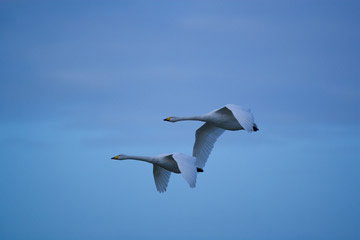Whooper Swan (Cygnus olor)

Whooper Swans © Simon Booth
Probably almost all of the Whooper Swans in the county are from Icelandic stock, as most of these birds winter in Britain and Ireland. Another population breeds in Fennoscandia and Arctic Russia, mostly wintering in continental Europe although there are records of some of these birds in Britain and Ireland (Migration Atlas) and it is well worth examining carefully any colour-marked birds seen for evidence of their origins. The UK wintering total more than trebled in the quarter-century to 2003/ 04; just over 15,000 were counted in the UK in the five-yearly International Swan Census in January 2005 (Eaton et al 2007). Most of the English birds are at Martin Mere and the Ouse Washes, and there is a lot of within-winter movement between Britain and Ireland (Migration Atlas), some of these birds passing through Cheshire and Wirral.
During this Atlas, most of the records are odd birds or small flocks. There was a maximum of 26 swans at Inner Marsh Farm in 2006/ 07 but otherwise the only tetrads with double-figure counts were the four on the south shore of the Mersey estuary, and the annual total in the county is a little under one hundred birds. The sum of the maximum tetrad counts submitted for this Atlas, probably with an element of double-counting, amounted to 83 birds in 2004/ 05, 63 of them on the Mersey; 63 birds in 2005/ 06, 45 of them on the Mersey; and a maximum in 2006/ 07 of 166 swans. This higher figure, however, includes a flock that was mobile between four tetrads on the Mersey; eliminating this double-counting leaves a total of 88 for the winter. No site has approached the level for national importance.
Coward & Oldham (1900) noted the Whooper Swan as ‘… a not infrequent visitor in winter to the Dee and Mersey estuaries’, although birds apparently stayed mostly on the mudflats, as Coward (1910) said that the species ‘seldom ascends as high as the marshes’; he mentioned flocks of 16, 40, 21 and 25 birds. Their scarcity inland was shown by Boyd, writing in 1951, who could quote only two winter records, more than thirty years old, from 1918/ 19 and 1919/ 20. Bell (1962) concurred, saying that ‘in recent times birds have occurred in most years in the estuaries in varying numbers’ but the records on inland waters averaged one every few years.
It seems from the old accounts that at some stage during the second half of the 20th century they switched their distribution, with Whooper Swan now being the bird most likely to be found inland, although the two winter swans are still both predominantly estuarine birds in the county. It is not clear from the annual bird reports, however, when this happened: from 1964 onwards Whooper Swans have been recorded at from 0-6 inland (non-estuarine) sites each winter, with year-to-year fluctuations but no significant change over forty years. This Atlas map, aggregating three winters’ records, exaggerates their annual status in showing birds present in 14 estuarine and 7 inland tetrads.
Underwater plants are their traditional food, and Whoopers are not as agile on land as Bewick’s Swans, but flocks will graze grass and winter cereals. Almost all of the county’s birds are on water, with odd records on potato fields and stubbles.
Sponsored by Ray and Liz Anslow

